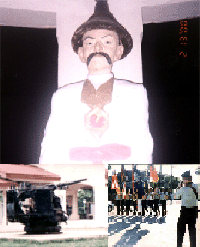|
|
 |
|
Boundary:
About the year 1406, Pangasinan comprised a much bigger territory than
what is now. It probably included, according to Dr. Austin Craig, the region now known as Zambales, Tarlac, the Ilocos
Province, and the Mountain Province. In 1572 Spaniards arrived in Pangasinan.
Again, in 1785 the northern
boundary was moved farther north to Bacnotan, La Union where it remained until the creation of La Union, and Tarlac were organized
as independent provinces, the size of Pangasinan territory was correspondingly reduced.
In 1902, the Rosales-Umingan region was added from Nueva Ecija, and in 1903
the northern towns of Zambales, namely Alaminos, Bolinao, San Isidro(Burgos), Infanta, Anda, Bani, and Agno were ceded to
Pangasinan.
The present boundary of Pangasinan was established in 1907.
|
 |
|
Origin of the Pangasinanes: Pangasinanes were of Malayan extraction. Pangasinan is a name given to an island in one Sulu group in
the archipelago of this name. Origin of the Malayan Filipinos, and the Pangasinenses settled in the region around Lanao
and Cotabato where the Magindanao dialect is spoken.
The Pangasinenses who are of Malayan stock occupied the greater part of Pangasinan and various towns, ranches,
and barrios of Zambales, Nueva Ecija and Benguet. King Kasikis and the Spaniards: King Kasikis was the ruler of the Luyag
na Caboloan Kingdom(Pangasina)when the Spaniards under Martin de Goite and Juan Salcedo arrived in the province during the
16th century.
Limahong in Pangasinan: This Chinese
pirate and corsair, Limahong wanted by the Chinese emperor for depredations on the Chinese sea coast, after an unsuccessful
attempt to establish a kingdom in Manila. Juan dela Cruz Palaris revolt against Spain during the 18th century.
The Palaris Revolt demonstrated the temper of the Pangasinenses in fighting their own rights against Spanish cruelties and
abuses.

The Revolution: Pangasinan joined the Revolution on March 7, 1898 at Laragan, Alos (now a barrio of Alaminos) under the leadership
of Ramon Manalang. Thirteen towns declared the revolution namely Alaminos, Bugallon, Lingayen, Agno, Bolinao, and Infanta.
On November 7, 1899, an American squadron bombarded the town of San Fabian, Pangasinan, ushering a new era-that of the American
occupation of the Philippines General Smith was appointed Military Governor of the province.
Most of Pangasinan youth organized
themselves into guerilla units in their clandestine fights against the Japanese.
This historical marker placed just behind the Lingayen capitol, recites in part: "…on
this beach…Gen. Of the Army Douglas began his campaign of 9th of January, 1945 for the liberation of Luzon from the
Japanese invaders."
|
 |
|
|
|
 |
|
|



